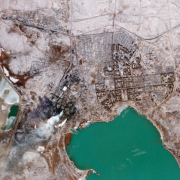Satellite Imagery Shows Home Depot is Busier than Lowe’s
Source- Washington Post
A few years ago, Americans who wanted to invest in China would have a lot of homework — and legwork – -to do. Most would have to hire someone halfway around the world to check out the investment for them. An investigator might drive for hours over the empty plains of Inner Mongolia, China’s far northern region, to make sure a remote mining operation really existed. Others would literally hide in the bushes to count trucks coming and going from a factory, or count the number of trees owned by a lumber operation.
Now, companies have a much simpler solution: monitoring investments across the world through photographs taken from space.
Satellite images contain a wealth of information about how much business a company is doing, and how much a country’s economy is growing. A hedge fund interested in investing in a Chinese miner, for example, might use the satellite images below to see how much the mine is really producing. By watching how a mine changes over hours or days, analysts can figure out how active the mine is.
In the image below, taken by satellites owned by space and analytics company Planet Labs, you can see how a gold mine in northern China changes between September and October. (Move the slider on the image back and forth to see the mine get deeper over the course of the month.)
Analysts are now using satellite imagery to examine everything from the lights cast by cities in India, to black market activity in North Korea, to how many people are shopping at Home Depot. As satellite imagery becomes more available, it will reshape how companies monitor their own and competitors’ operations, and make investors huge amounts of money. It will also generate privacy concerns, as anyone’s activity outside is now visible to the highest bidder.
Read the rest here

